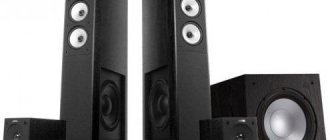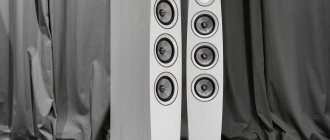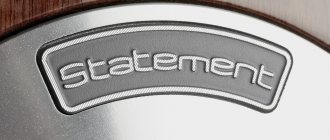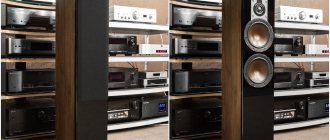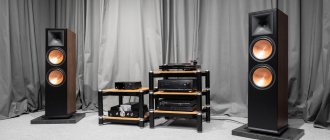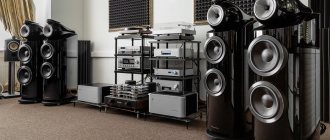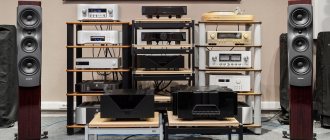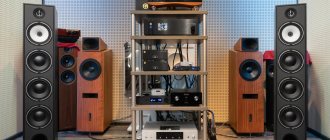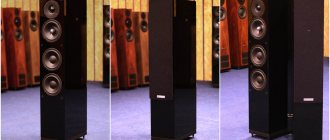Heco is almost 67 years old. And I am surprised by their truly German stability - all this time the company has used exclusively traditional speaker manufacturing technologies. Of course, it improves and nurtures these technologies year after year, and older models with an open design and alnico magnet are the most striking example of this. The relatively inexpensive lines also have a lot of interesting solutions, but at the same time there is a sense of healthy conservatism. The acoustics remain ordinary acoustics. However, is more needed?
External superiority
The Heco Elementa acoustics have a rectangular body profile with strongly rounded front edges. There are two finishes: black and white, both versions are completely matte. Finally, the fashion for gloss has passed, which loves to collect dust and fingerprints, and also makes the smallest scratches noticeable. I note that the matte finish does not look cheap at all. On the contrary, the acoustics have only benefited from this and look stylish and modern. Adding to the aesthetics are magnetic fastenings for grills, thanks to which the façade has no extra holes.
The cabinets themselves are made from MDF and have internal bracing for added strength. The acoustic design is bass reflex, with two ports of a special aerodynamic shape, fixed in the body with screws. Unlike older models, Elementa has ports made of plastic with a coating that imitates aluminum. It looks almost indistinguishable from real metal ones, and their shape is basically identical.
Both with and without a grill - the acoustics look equally good
Thick aluminum platforms are screwed into the base of the case, extending beyond the dimensions of the case. Spikes or legs with rubber tips are screwed into the protruding parts. Both are conveniently adjustable in height using large-diameter rotating handles: there is no need to put your hand under the acoustics, feel the edges with a key and experience other inconveniences.
In the best traditions
The Elementa line in the Heco catalog appeared as a result of optimization and rethinking of the design of the older Celan line. In order to reduce costs, engineers not only simplified the shape of the body and replaced the aluminum bass reflex with a plastic one, but also unified the drivers. Celan's midrange frequencies were reproduced by a special driver with a corrugated fabric suspension, similar to vintage wideband speakers, while Elementa's midrange and bass drivers had the same appearance.
The midrange driver is equipped with a long-fiber cellulose cone with a large dust cap in the center
Both feature cone-shaped diffusers made from long-fiber cellulose with a large dust insert in the center and a soft semi-circular profile rubber surround that provides long stroke. However, the latter is only relevant for bass drivers; the midrange driver, by definition, has a smaller stroke; in addition, the Elementa has a more elastic centering washer, which gives more control, but less freedom of movement.
The midrange and bass drivers are identical in appearance, but the midrange driver has a lesser degree of freedom due to a more elastic centering washer
Despite the fact that the developers took the path of reducing the cost, this did not affect the speaker baskets - they are cast from aluminum. The speaker flanges are laser processed, so they look perfectly smooth and shiny. The design of the basket is as open as possible, it is “aerodynamic” in shape for the free passage of air, eliminating compression and reflections. The magnetic system is assembled on two ferrite magnets of different sizes, the second one is slightly smaller than the main one. Most likely, this is a so-called countermagnet, with the help of which the magnetic field of the main magnet is more efficiently distributed along the working area of the voice coil.
A larger tweeter often sounds more natural
The tweeter has a silk dome of increased size - 28 mm (versus the standard 25 mm). This approach is not surprising, since Heco makes most of its speakers itself, and those that are manufactured by third parties are assembled according to drawings and precise specifications. You can make it at least 28 mm, at least 32 - that would make sense. And in this case it is: the larger the working surface of the tweeter, the more natural and fuller the sound of the upper frequencies, and the better it fits into the midrange. Like larger speakers, the tweeter has a dual ferrite magnet and an aluminum housing with a flange that looks like a shallow horn.
Two bass drivers with soft rubber surrounds and a large stroke are loaded on a pair of bass reflexes
The crossover, as the company writes, equalizes not only the frequency response, but also the phase response. Its special feature is the fifth terminal, which allows you to add 2 dB to the tweeter output. It is curious that this function is only available on the Elementa 700 floorstands, while the Elementa 300 shelfstands already have a standard set of four terminals.
Heco Elementa 300 bookshelf monitors
Not long ago we listened to Heco Elementa 700 floor-standing speakers in combination with amplification components of different classes. Now we will subject a shelf model from the same new series to a similar test, which fits well between the budget Heco Music Style line and the advanced mid-range Celan GT.
The external differences between the “three hundred” and the older floor-standing models, in addition to the two-lane design, come down only to the height and depth of the MDF cases. They are identical in finish (matte varnish) and in the method of attaching the grills (with magnets), in acoustic design (bass reflex with a rounded port at the rear) and in the width of the front panels. You can make the comparison yourself if you open a previously published test.
The front part of the monitors has a traditional layout with a top-mounted tweeter. Branded tweeters with a fabric dome with a diameter of 28 mm and a chiseled bell are approximately the same class as those installed in the Aleva series (at least they are equipped with a magnetic system of two ferrites). Midbass 17-centimeter heads also have all the family characteristics. A lightweight diffuser made of long-fiber cellulose with an almost flat central cap is attached through an elastic rubber suspension that allows significant vibration amplitudes. The metallic shine on the flanges is made for greater solidity and beauty, and this is not an imitation - the driver baskets are really cast from aluminum. These speakers also have double magnetic systems.
I would like to draw attention to the characteristics declared by the manufacturer, or more precisely, to the combination of high sensitivity with an unusually wide reproducible frequency band for bookshelf speakers. With such outstanding efficiency, the compact Elementa 300 are at least intended to be universal speakers, suitable for any system tasks and listening conditions.
The metallic shine on the flanges is made for greater solidity and beauty, and this is not an imitation - the driver baskets are really cast from aluminum.
The second feature of the acoustics is crossover filters made of high-quality elements, optimized not only for frequency, but also for phase characteristics. Creating such is a non-trivial task in itself. Heco greatly simplifies its solution by independently producing heads with the necessary parameters. It’s a pity, however, that the filters in the “three hundred” do not have a high-frequency attenuator - on the rear panel you will not find an additional fifth terminal, as on the Elementa 700, connection to which provided an increase in HF by +2 dB. Here we are left with a set of four standard terminals for by-wiring or by-amping connections, which, in my opinion, is not particularly relevant for shelf speakers. I would prefer to see the same four gold-plated sockets in a different quality - for example, for a simple single-way connection, but with the ability to attenuate the low-frequency response (relevant for wall-mounted or shelf-mounted speakers) and obtain the already mentioned above-mentioned gain at the highest frequencies, to which you can resort in crowded rooms.
In our case, the acoustics were installed on racks in a free field, more than a meter away from the walls. And the very first inclusion showed that they, at a minimum, can be considered as an alternative to full-range floor-standing speakers. You won’t hear such a detailed and meaty bass even from some impressive “towers”. Surprisingly, these players do not miss even the lowest organ components and voice them with such energy that you are immediately imbued with respect.
As in the case of the Elementa 700, the “three hundred” do not have the problem of compatibility with large rooms. In a room of up to 40 - 50 m2, you can easily get dynamic, energetic reproduction that is not inferior in intelligibility to older models. Most likely, you will think that there is a cabinet or bass reflex tint in the sound, but do not rush to conclusions. If we were dealing with real resonances or introduced overtones, then there would be no need to talk about any clarity. Here everything is the other way around. Yes, the lower vocal range is presented a little deliberately, but listen how organic it is! And how expressively and corrosively, down to the smallest vibrations, the “wood” of the soundboards stands out... The biting clean attack of the drums is literally imprinted on the chest, and the bass does not get bogged down in its own low peals. So, most likely, we are dealing with a specific frequency response, which, in a subjective opinion, has a slight “flat” rise in a wide region of 100 - 300 Hz above the main band. Added to this is high phase accuracy, without which the low-mid register would never have been reproduced so texturally and tactilely.
I note that the listed qualities are manifested in any path - both with a McIntosh integrated receiver and with a Denon multi-channel theater receiver. I am sure that the “three hundred” will become an easy load for systems with much less powerful amplification. They sound absolutely relaxed, without any signs of compression.
The second feature of the acoustics is crossover filters made of high-quality elements, optimized not only for frequency, but also for phase characteristics.
The system factor in the case of the Elementa 300 is decisive when we talk about the quality of transmission in the mid and upper range. In a simpler path, this acoustics, for example, shows a slight emphasis in the region of 800 - 1000 Hz. In the higher spectrum, some kind of excess “creakiness” creeps in. The acoustics can also be blamed for the lack of the highest air components, which makes it difficult to perceive the sound space as a clearly defined volume around you. The stereo image itself is amazing, if we talk about the images that make it up, but the imaginary images placed in the depths or on the flanks of the scene seem to be suspended in a vacuum. Hardware tint also adds “synthetics” to the reproduction, the roots of which, however, should be sought not in acoustics, but in components.
A completely different listening experience remains in a system with an audiophile stereo amplifier and a Hi-Res source. Already at low volumes, a clear, but at the same time “atmospheric” sound space is built. There is no longer uncertainty in the background, although it does not captivate with particular depth. And when you start listening to something orchestral, the intensity of emotions reaches its highest point. The solo instrument and the foreground are in full view. The entire string group is very realistic - there is a clear pluck and “wood”, “rosin” and all the non-musical background components. Even though the “copper” still suffers from slight aggression, it is no longer annoying to the ear – the overall increase in information content and sound plasticity immediately covers all the minor shortcomings.
This is the best evidence that the Elementa 300 in their price niche have a really high sound resolution, expressed not so much through microdynamics (especially at high frequencies, where detail, frankly, is not very good), but through the naturalness and fullness of timbres. On the other hand, the new Heco bookshelf units may be too harsh judges both for components of insufficiently high quality and for connecting cables.
Heco Elementa 300
Manufacturer: Magnat Audio-Produkte GmbH (Germany)
www.heco-audio.de
Configuration: 2 emitters, 2 bands || Acoustic design: bass reflex || Frequency range: 32 - 45,000 Hz || Sensitivity: 90 dB (1 W/1 m) || Resistance: 4 – 8 Ohms || Crossover frequencies: 3200 Hz || Recommended amplifier power: 30 – 150 W || Finish: Matte Black, Silky White || Dimensions with supports: 226 x 368 x 325 mm || Weight: 7.5 kg || Price per pair: 59,900 rub.
The biting clean attack of the drums is literally imprinted on the chest, and the bass does not get bogged down in its own low peals.
COMPONENTS
- Sources: Denon DBT-3313UD player
- McIntosh MCD550 turntable
- laptop Apple MacBook Air A1465
- NAS storage Synology DS 115
- digital Blue Dual Shield USB 2.0 AB and InAkustik HDMI High Speed 2.0
The entire string group is very realistic - there is a clear pluck and “wood”, “rosin” and all the non-musical background components.
share
Tags: Elementa 300HECOobzoryGood buy
With or without plus
Before studying the nuances of the Elementa 700 sound, I had to decide with what connection to listen to the acoustics: +2 dB or with a flat frequency response. The audiophile gut told us that we didn’t need the extra decibels, but for quiet rooms the manufacturer recommends using the +2 dB terminal.
The additional terminal gives +2 dB to the high-frequency response. Whether this is necessary or not is up to the user to decide.
After listening to both options, I came to the conclusion that even in an acoustically prepared room, which is sufficiently attenuated, the +2 dB terminal produces excessive brightness at high frequencies. For example, on Dave Brubek’s “Take Five” recording, the cymbals are soloed and begin to tire by the middle of the composition. The effect is the same on music of other styles, genres and years of recording. There is an underlining, an accentuation of the upper ones, which makes the sound effective, but tiring. In a Hi-Fi salon, in order to hook the buyer, such sound will probably work, but for long and thoughtful listening, extra decibels are not needed.
Probably the most comfortable adjustable feet I've ever seen. And they don’t spoil the appearance, which is surprising
While I was fiddling with the terminals, I already had an overall idea of the sound of the Elementa 700; all that remained was to figure out the nuances. The overall impression is: smooth tonal balance, detailed and expressive sound with good rhythm. Almost the entire range was perfectly controlled. I attribute some of the boominess in the lower bass to room resonances and the peculiarity of the bass reflexes, which are tuned quite low. In 90 percent of cases, the booming as such cannot be heard; there is a clear, perfectly controlled bass, similar in character not to a bass-reflex speaker, but to a closed acoustic system.
This is what rubber legs look like, but the cone can also end in a sharp spike
The sound direction of the Elementa 700 is not pronounced, the sound is dispersed evenly, and when deviating from the axis, the tonal balance changes smoothly. For cinema applications this is an important and useful property. But the most interesting thing happens at the focal point. When you turn the radiation axis directly towards the listener, you get a focused sound stage. The sensations are very close to those you experience when listening to acoustics with coaxial or full-range speakers.
Hidden character
On the composition “While I look at you” by Evie Sands, the vocals sound very natural, the recording simultaneously created a feeling of high detail, but at the same time it is difficult to distinguish any instruments from the overall picture. In combination with McIntosh components, the acoustics painted a sound picture whole, in large strokes. On the recording of “Fever (Take1)” by Elvis Presley, the conversations in the studio and the noise of the equipment are clearly audible. There is still a feeling that the resolution of the Elementa 700 is similar to that of a significantly more expensive acoustic system, but the detail, unlike older models, does not prevail over the integrity and melody of the sound. On “Let There be Love” by Laura Fygi, the vocals are perfectly articulated, the mids and tops are just right. The percussion is clear, rhythmic, every rustle of brushes, light blow on the drums - everything is perfectly audible.
While I was sorting through audiophile recordings, I came to the conclusion that the resolution of the tweeter is slightly higher than that of the mid- and low-frequency drivers, which is why such a strange effect occurs: there is a feeling of high resolution, but the details seem to be a little blurred. Perhaps this is a consequence of the novelty of the sample being listened to, and after a hundred or two hours the speakers will play out.
The name plate with the model name is located at the top, along the edge farthest from the listener
The tweeter is as informative as possible: it makes it possible to hear the air and upper harmonics, while the mids and lows are presented a little softer, as speakers with paper diffusers usually do. For home acoustics, this is undoubtedly a plus. The only case when I wanted to add more density, composure and clarity to the sound of the mids and lows was fast, heavy music. For Rage, Slipknot and System of a Down, the mids of the Elementa 700 are not hard and “angry” enough, and the bass is not so dense and “punchy”. A similar effect was observed on electronic music with an aggressive presentation. In all other cases, the nature of the sound of the system benefits the perception, providing a comfortable and expressive presentation of completely different musical material.
To understand how rhythmic the Elementa 700 is, it was enough for me to listen to “La Grange” by ZZ Top. This is, of course, not metal, but the music is heavy and fast. Her acoustics played confidently.
The Elementa line of acoustics lives up to its name, everything is elementary simple: two colors, in addition to the subwoofer and the center there is one floor stand and one shelf stand
In other words, with the exception of extreme genres, the Elementa 700 is quite versatile and effective. If we keep in mind the relatively affordable price tag, we can say that the standard set of audiophile tracks is reproduced either just well or completely excellent. The acoustics display their character minimally, but can easily play with both budget and expensive equipment.
Big cinema
The first audition of the system took place in an expanded format using the ceiling speakers already in the showroom, the class of which was comparable to the tested Elementa series. The feeling of volume and three-dimensional sound picture was absolutely complete. The sounds were localized in space clearly and unambiguously; it was completely impossible to understand where the acoustics were located.
Adjustable high-frequency output is useful when this setting is not available in the receiver
The result was so impressive that I expected a significant deterioration in terms of the transfer of space and three-dimensionality of the sound image when moving to 5.1 format. However, there were not so many losses. The abandonment of four ceiling speakers, of course, changed the perception, but even in this format, sound effects periodically flew somewhere overhead. Not as impressive as in Dolby Atmos mode, but enough to understand that one bullet whistled somewhere high, and the second flew at shoulder level.
There is a bass reflex in the central channel and it is rear, so you should carefully choose the installation location
I would like to note that the rear bookshelf speakers were placed in the least advantageous position, on standard stands, and not above the level of the listener’s ears (as they are usually recommended to be placed in a home theater).
The subwoofer has a good set of adjustments, it’s a pity that there are no high-level inputs
I didn't hear any pronounced accents in the sound. During my first test of the Elementa 700 as a stereo pair, the low and mid bass seemed a little light to me, and in heavy and aggressive music the attack turned out to be more delicate than expected. In a cinema with subwoofer support, this effect was virtually neutralized, but all the other advantages of paper speakers were fully revealed.
The cornerstone of the entire line is midrange/woofer speakers with paper cones.
In the film "Batman v Superman: Dawn of Justice" in the episode when the police enter an abandoned house, the tense atmosphere is perfectly conveyed, with barely audible rustles and creaks surrounding on all sides. In the combat scenes of the film "Sniper", the sounds of a shot are very believable, they are sharp, biting, abrupt, with natural echoes. The clanging of the tank tracks in Saving Private Ryan is no less realistic. The ringing of metal combined with a heavy, literally physically palpable roar was very convincing.
The tweeters are also quite good and have a wide dispersion
The high resolution of the acoustics made it possible to accurately determine the quality of the audio track. If the sound is harsh at times and lacks a little naturalness and sense of space, it's good old Dolby Digital. If the dialogue sounds as if a person is standing and talking next to you, rest assured that Dolby TrueHD or DTS-HD is playing.
On the bass, small low-frequency speakers received support in the form of a subwoofer, which clearly added energy to this register
The wide arrangement of acoustics, absolutely effective in cinema mode, proved to be no less successful when playing multi-channel music recordings and concert videos. It is quite possible to feel yourself in the center of events, as advertising brochures usually promise us. If you switch to stereo mode, there is a desire to reduce the size of the stereo base.
Aluminum podiums with adjustable legs - a luxury that is becoming more affordable
With a “cinema” arrangement, the sound turns out to be three-dimensional; it is still not tied to acoustics, and even taking into account the large width of the arrangement, it may well go beyond the stereo base. But at the same time, the depth and proportions of the stage in the center suffer. The desired depth can only be achieved by moving the floor panels closer to each other.


